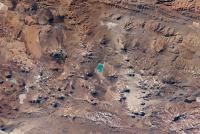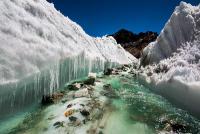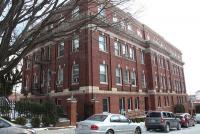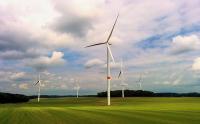-
Inspired by bats, sensor technology detects dangerous structural cracks

Researchers have developed an ultrasound sensor for detecting dangerous cracks in structures such as aircraft engines, oil, and gas pipelines, and nuclear plants. The device, known as a transducer, identifies structural defects with varying ultrasonic frequencies and overcomes the limits of other, similar devices, which are based on rigid structures and have narrow ranges. It is thought to be the first device of its kind in the world.
-
-
Geoengineering technique would not stop sea level rise

Researchers used computer model experiments to test how the Greenland Ice Sheet would react to albedo modification, also called solar radiation management geoengineering, a proposed technology to cool down the Earth’s temperature by reflecting some sunlight away from the planet. They found the ice sheet might contribute to sea-level rise for decades to centuries after albedo modification began. The researchers say that albedo modification should not be counted on as a short-term solution to stop rising global sea levels.
-
-
Up to 30 percent less precipitation in the Central Andes in future

Seasonal water shortages already occur in the Central Andes of Peru and Bolivia. By the end of the century, precipitation could fall by up to 30 percent according to an international team of researchers. Researchers show that precipitation in the rainy season could drop noticeably - and this could happen within the next twenty years.
-
-
Physics class drops “by-rote” experiments to encourage critical thinking
When an experiment does not go as expected in a new introductory physics lab at the University of British Columbia (UBC) this September, students will take a real-world approach to the “failure.” They will compare their experimental data to other students’ data and to simplified models, think critically, and then rework the science — on their own. And according to new UBC research in the Proceedings of the National Academy of Sciences, the self-directed, iterative learning approach dramatically improves students’ critical thinking skills.
-
-
U.S. Navy champions unmanned systems over, on, and under the sea
The presence of unmanned systems in the maritime military domain is growing, and the U.S. Navy has decided to make several organizational, and conceptual, changes in order to deal with unmanned systems in a more holistic fashion. Rear Adm. Robert P. Girrier has been named the Navy’s first director of unmanned weapon systems, and Secretary of the Navy Ray Mabus announced in April that he would appoint a new Deputy Assistant Secretary of the Navy for Unmanned Systems, “so that all aspects of unmanned — in all domains — over, on and under the sea and coming from the sea to operate on land — will be coordinated and championed.”
-
-
Florida teens hold their own in challenging maritime robotics competitions
For the past three years, Team S.S. Minnow from Florida – consisting of Nick Serle, 15, and Abby Butka, 14 – has been competing against some of the finest technical universities in the world via the SeaPerch, RoboSub, and RoboBoat robotic competitions, all cosponsored by the Office of Naval Research (ONR). “I’ve seen Nick and Abby rise through these contests and become fierce competitors,” said Kelly Cooper, a program officer in ONR’s Sea Warfare and Weapons Department. “It is success stories like theirs that motivate us to support these competitions.”
-
-
Space elevator technology granted U.S. patent

Pembroke, Ontario-based space company Thoth Technology has been granted the United States patent for a space elevator. The space elevator is a freestanding space tower which is pneumatically pressurized and actively guided over its base. The company envisions a tower 20 km tall, which is more than twenty times the height of current tall structures. The space tower will be used for wind-energy generation, communications, and tourism.
-
-
Warming-driven substantial glacier ice loss in Central Asia imperils water supplies

Central Asia is the outstanding case for human dependence on water seasonally delayed by glaciers. Nowhere the question about the glacier state is linked so closely to questions of water availability and, thus, food security. The glaciers in Central Asia, however, experience substantial losses in glacier mass and area. Along the Tien Shan, Central Asia’s largest mountain range, glaciers have lost 27 percent of their mass and 18 percent of their area during the last fifty years. Scientists estimate that almost 3,000 square kilometers of glaciers and an average of 5.4 gigatons of ice per year have been lost since the 1960s, saying that about half of Tien Shan’s glacier volume could be depleted by the 2050s.
-
-
U.Va. upgrades IT systems after massive Chinese cyberattack

The University of Virginia announced Sunday (16 August) that it has successfully completed a comprehensive system security upgrade in response to a cyberattack originating in China. The University said it had taken these actions further to enhance the security of data and information stored on university resources and to aid in prevention of future cyberattacks. The cyberattack on U.Va. is the second massive cyberattack by Chinese government hackers on an American institution of higher learning. Last fall, the Penn State College of Engineering was the target of two sophisticated cyberattacks by Chinese government hackers.
-
-
Counter-drone technologies demonstrated at DoD’s Black Dart event
Small, unmanned aircraft systems (UASs, aka UAVs, for unmanned aerial vehicle), or drones, are easy to obtain and launch and they are hard to detect on radar, making them of particular concern to law enforcement and the Department of Defense. Earlier this month DHS circulated an intelligence assessment to police agencies across the United States warning about drones being used as weapons in an attack. DOD says that Black Dart 2015, which began 26 July and ran through 7 August, is the Department of Defense’s largest live-fly, live-fire joint counter-UAS technology demonstration. One of the innovative developers of counter-UAS technologies is SRC Inc., a not-for-profit company formerly affiliated with Syracuse University. The company showed its SR Hawk surveillance radar, which is integral to its layered approach to defending against UASs.
-
-
DHS S&T licenses innovative communication technology to commercial partners
DHS Science and Technology Directorate (S&T) last week announced that it has licensed the Radio Internet-Protocol Communications Module (RIC-M) to two commercial partners. RIC-M, used by local, state, and federal responders, is a low-cost, external, stand-alone, interface device that connects radio frequency (RF) system base stations, consoles and other RF equipment — regardless of brand — over the Internet or Private Internet Protocol (IP) network.
-
-
Toxic blue-green algae a growing threat to nation’s drinking, recreational water
A new report concludes that blooms of toxic cyanobacteria, or blue-green algae, are a poorly monitored and underappreciated risk to recreational and drinking water quality in the United States, and may increasingly pose a global health threat. Several factors are contributing to the concern. Temperatures and carbon dioxide levels have risen, many rivers have been dammed worldwide, and wastewater nutrients or agricultural fertilizers in various situations can cause problems in rivers, lakes, and reservoirs.
-
-
DOE’s rare-earth recycling invention commercially licensed
The Department of Energy’s Critical Materials Institute (CMI) seeks ways to eliminate and reduce reliance on rare-earth metals and other materials critical to the success of high-tech industries. A new technology developed by CMI aids in the recycling, recovery, and extraction of rare earth minerals. It has been licensed to U.S. Rare Earths, Inc. The membrane solvent extraction system is the first commercially licensed technology developed through the CMI.
-
-
Three new Engineering Research Centers to advance U.S. resiliency, sustainability

The NSF awards $55.5 million for compact mobile power, off-grid water treatment, and nature-inspired soil engineering. The NSF says that innovations that improve the affordability, availability, quality, and resilience of infrastructure services will enhance the nation’s economic competitiveness and societal well-being.
-
-
Price of wind energy in U.S. at an all-time low, spurring demand

Wind energy pricing is at an all-time low, according to a new report released by the U.S. Department of Energy. The prices offered by wind projects to utility purchasers averaged under 2.5¢/kWh for projects negotiating contracts in 2014, spurring demand for wind energy.
-
More headlines
The long view
New Technology is Keeping the Skies Safe
DHS S&T Baggage, Cargo, and People Screening (BCP) Program develops state-of-the-art screening solutions to help secure airspace, communities, and borders
Factories First: Winning the Drone War Before It Starts
Wars are won by factories before they are won on the battlefield,Martin C. Feldmann writes, noting that the United States lacks the manufacturing depth for the coming drone age. Rectifying this situation “will take far more than procurement tweaks,” Feldmann writes. “It demands a national-level, wartime-scale industrial mobilization.”
How Artificial General Intelligence Could Affect the Rise and Fall of Nations
Visions for potential AGI futures: A new report from RAND aims to stimulate thinking among policymakers about possible impacts of the development of artificial general intelligence (AGI) on geopolitics and the world order.
Smaller Nuclear Reactors Spark Renewed Interest in a Once-Shunned Energy Source
In the past two years, half the states have taken action to promote nuclear power, from creating nuclear task forces to integrating nuclear into long-term energy plans.
Keeping the Lights on with Nuclear Waste: Radiochemistry Transforms Nuclear Waste into Strategic Materials
How UNLV radiochemistry is pioneering the future of energy in the Southwest by salvaging strategic materials from nuclear dumps –and making it safe.
Model Predicts Long-Term Effects of Nuclear Waste on Underground Disposal Systems
The simulations matched results from an underground lab experiment in Switzerland, suggesting modeling could be used to validate the safety of nuclear disposal sites.
